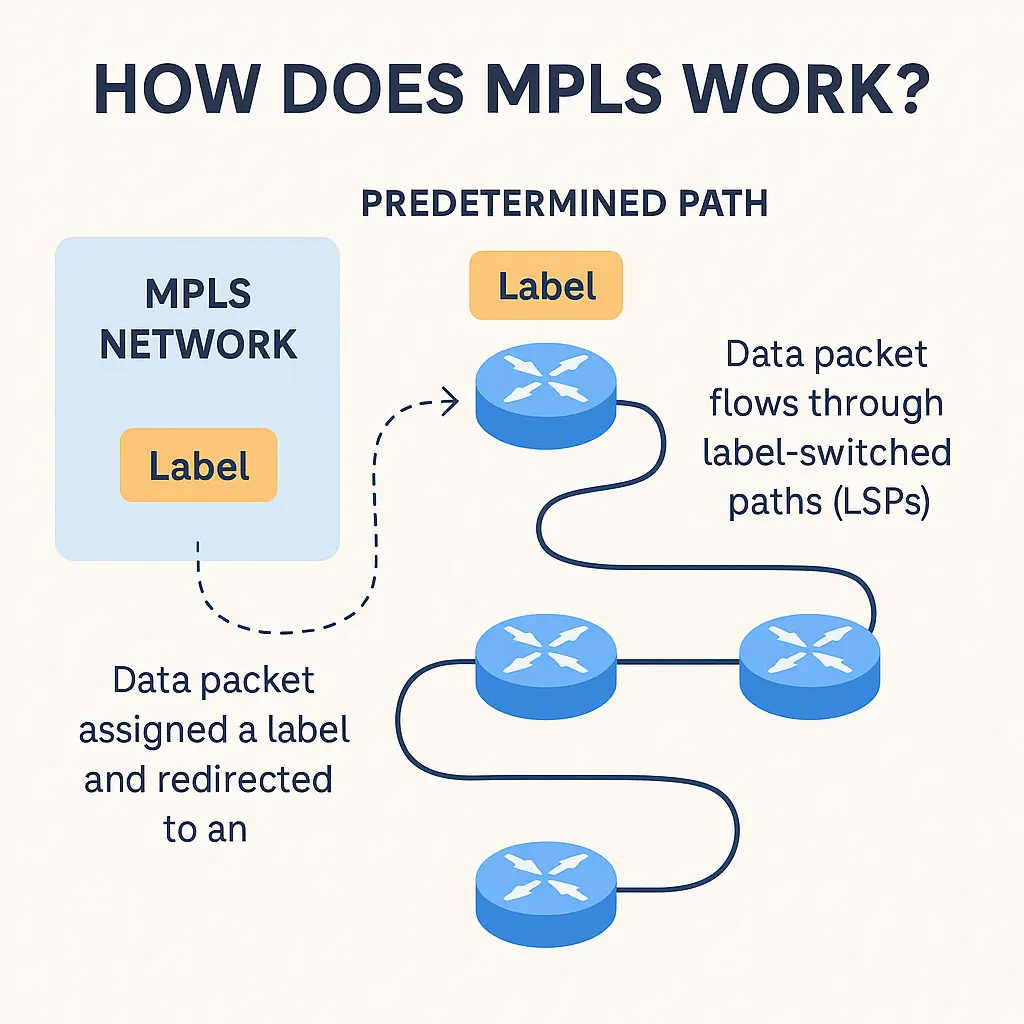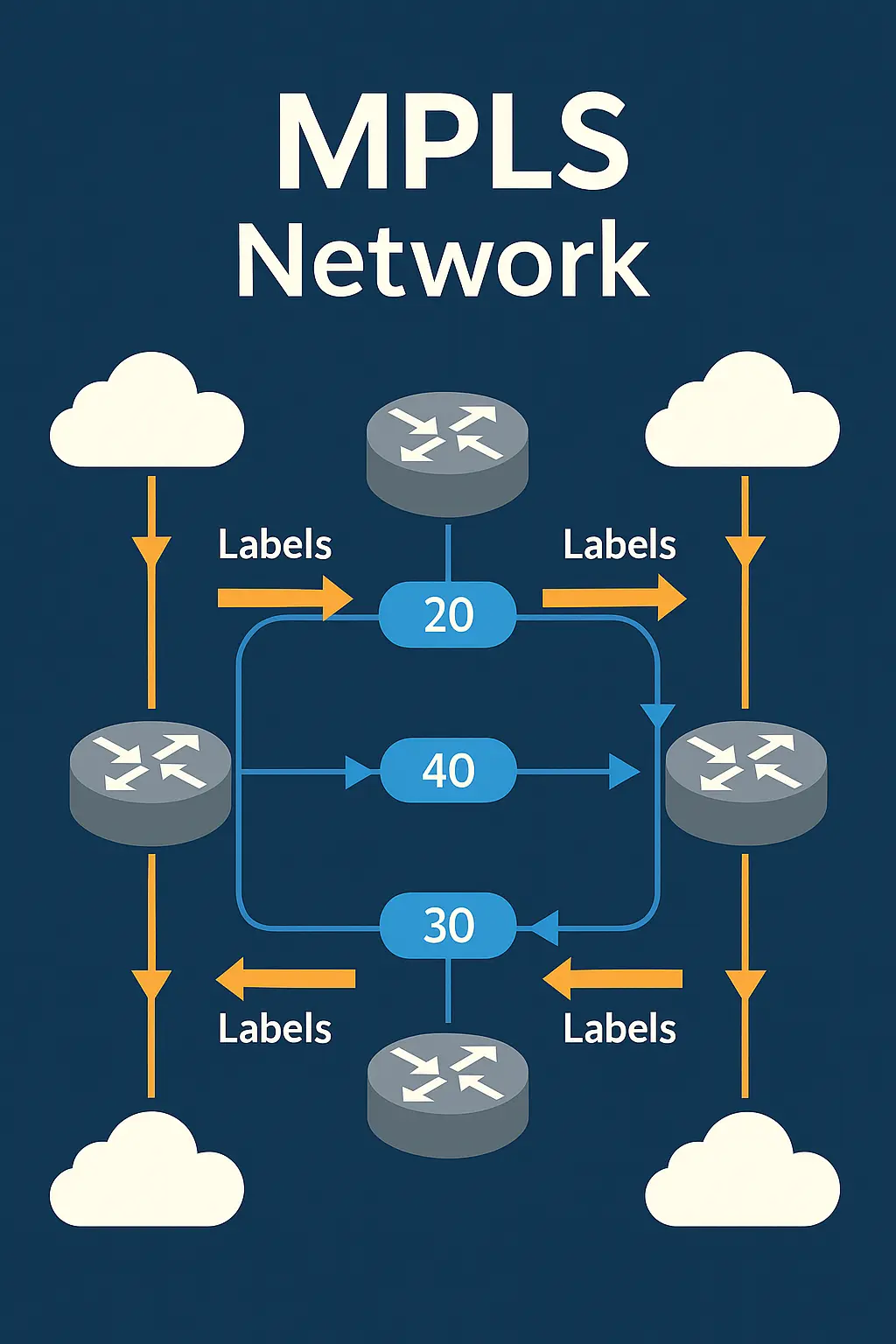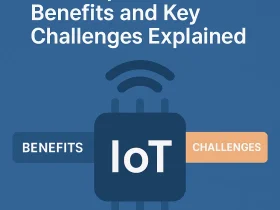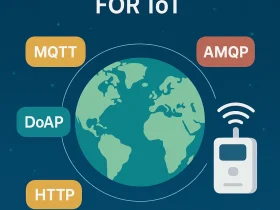What is MPLS Network? Full Guide 2025
Introduction to MPLS
In a digital-first world where connectivity determines productivity, organizations demand networks that are fast, reliable, and secure. Multiprotocol Label Switching, abbreviated as MPLS, has emerged as one of the key technologies that power modern enterprise connectivity.
From financial services to healthcare and global manufacturing, MPLS is often used to connect geographically dispersed offices with consistent performance guarantees. But before you consider deploying it or migrating from it, it’s critical to understand what MPLS is, how it works, and what makes it distinct.
This detailed guide covers everything from the basics to the internals, so both beginners and IT professionals can understand the role and relevance of MPLS in today’s network ecosystem.
What is MPLS? – Understanding the Basics
MPLS (Multiprotocol Label Switching) is a type of data-carrying technique used to direct data from one node to another based on short path labels rather than long network addresses. These labels identify virtual links (paths) between distant nodes rather than endpoints.
Unlike traditional IP routing where routers examine the packet header each time it arrives at a new node, MPLS assigns a label to each packet when it enters the network. This label instructs each router in the network about where the packet should go next, significantly reducing latency and increasing efficiency.
MPLS Full Form:
- MPLS stands for Multiprotocol Label Switching
- Multiprotocol: Works across IP, ATM, Frame Relay, etc.
- Label Switching: Makes routing decisions based on labels, not IP addresses
This makes MPLS:
- Protocol-agnostic
- Highly efficient
- Scalable for large networks
MPLS in the OSI Model – The Layer 2.5 Concept
MPLS operates in a unique space within the OSI model, often referred to as Layer 2.5.
- Layer 2: Data Link Layer
- Layer 3: Network Layer
MPLS does not replace these layers but works in between them. It intercepts IP packets after Layer 2 and before Layer 3, assigning labels to these packets and directing them through label-switched paths (LSPs).
This Layer 2.5 position allows MPLS to combine:
- The speed and simplicity of switching (Layer 2)
- The intelligence and flexibility of routing (Layer 3)
See also: What is the OSI Model? Understanding the 7 Layers of OSI
How Does MPLS Work?

Traditional IP routing works on the principle of hop-by-hop forwarding, where every router inspects the packet’s IP header to determine the next hop.
In contrast, MPLS uses a concept of labeling, allowing routers to forward packets based on fixed paths with minimal overhead.
MPLS Packet Forwarding: Step-by-Step
- Ingress (Entry Point):
- The first router, called a Label Edge Router (LER), receives an IP packet and attaches a label based on the destination and service level (QoS).
- Path Creation:
- Predefined Label-Switched Paths (LSPs) are created between LERs using protocols like LDP or RSVP-TE.
- Label Switching:
- Each intermediate Label Switching Router (LSR) examines the label, not the IP header, swaps it with a new one, and forwards the packet.
- Egress (Exit Point):
- The final LER removes the label and sends the packet to the destination using traditional IP routing.
This process is like sending a parcel where sorting centers route the package based on a barcode rather than opening and reading the address label at every stop.
Label-Switched Paths (LSPs)
- LSPs are the backbone of MPLS
- They ensure predetermined, reliable, and efficient routes
- They are created and maintained dynamically or manually depending on routing policies
See also: What is Network Core? Beginner to Expert Guide 2025
Applications of MPLS Networks
MPLS is often deployed in complex enterprise and telecom environments for:
- WAN Optimization: Efficient routing between branches
- Voice and Video Traffic: Low-latency transmission with QoS
- Data Center Connectivity: Stable and fast communication
- Disaster Recovery Networks: Fast re-routing in case of failures
- Multicast Applications: Support for broadcast traffic
Pros and Cons of MPLS
Understanding the benefits and trade-offs of MPLS helps organizations determine if it’s the right fit for their network infrastructure.
Advantages of MPLS
| Feature | Description |
|---|---|
| Predictable Performance | Dedicated paths ensure consistent latency and throughput |
| Enhanced Security | Isolated from public internet, reducing exposure to attacks |
| Quality of Service (QoS) | Prioritizes traffic types (e.g., VoIP, video) |
| Scalability | Easily accommodates expanding enterprise networks |
| Reduced Congestion | Less packet loss due to controlled routing |
Disadvantages of MPLS
| Limitation | Description |
|---|---|
| High Cost | MPLS circuits are expensive compared to broadband |
| Cloud Integration | Direct cloud access is limited or inefficient |
| Deployment Time | Configuration and provisioning can be slow |
| Location Limitations | Not always available in rural or remote regions |
MPLS vs Traditional IP Routing
| Feature | MPLS | IP Routing |
|---|---|---|
| Routing Method | Label-based | IP address-based |
| Speed | Faster due to label lookup | Slower due to route table checks |
| Reliability | High | Variable |
| Traffic Engineering | Supported | Limited |
| QoS | Strong | Weak |
| Cost | Higher | Lower |
MPLS vs SD-WAN
With the rise of cloud computing, many organizations are adopting Software-Defined WAN (SD-WAN). How does it compare with MPLS?
| Feature | MPLS | SD-WAN |
|---|---|---|
| Performance | Reliable and consistent | Depends on underlying transport |
| Cost | Expensive | Cost-effective |
| Cloud Readiness | Low | High |
| Deployment Speed | Slow | Fast |
| Flexibility | Limited | Highly adaptable |
Conclusion: Hybrid environments often combine both MPLS (for mission-critical traffic) and SD-WAN (for cloud and internet-based applications).
See more: SDWAN vs MPLS | Difference between SDWAN and MPLS
Is MPLS Still Relevant in 2025?
While the networking world is shifting rapidly towards SD-WAN and cloud-first models, MPLS is not obsolete. In fact, many organizations still rely on MPLS for its:
- Proven reliability
- Low-latency communication
- Secure and private connectivity
Industries like banking, logistics, and healthcare continue to depend on MPLS for applications where performance and compliance are critical.
That said, for businesses that need agility, scalability, and direct cloud access, SD-WAN is increasingly being considered either as a complement or a replacement.
See also: Why Do We Need Internet of Things? Importance of IoT in 2025
Frequently Asked Questions (FAQs)
Q1. What is the MPLS full form?
Multiprotocol Label Switching
Q2. What is MPLS in simple words?
MPLS is a way to speed up data transmission in a network by tagging packets with labels instead of relying on IP lookups at every hop.
Q3. How does MPLS work in networking?
It creates a predefined route for packets using labels. Each label tells the router where to send the packet next, ensuring faster delivery.
Q4. What are the main advantages of MPLS?
- Speed
- Reliability
- Security
- Predictable performance
- Support for QoS
Q5. Is MPLS better than SD-WAN?
MPLS offers better performance and security, but SD-WAN is more flexible and affordable. A hybrid approach often brings the best of both worlds.
See also: How to Use IoT Device Over Internet: A Beginner’s Guide
Conclusion
MPLS remains a critical part of many organizations’ networking strategies in 2025. While newer technologies like SD-WAN and cloud networking gain traction, MPLS offers unmatched performance and reliability for many use cases.
Whether you’re considering MPLS for the first time or wondering if it’s time to transition to SD-WAN, understanding its inner workings, benefits, and limitations is essential.
If your business relies on mission-critical, latency-sensitive applications and secure multi-site connectivity, MPLS might still be your best bet.
For agile, cloud-centric networks looking to cut costs, SD-WAN is worth exploring—perhaps alongside MPLS.
See also: IoT Security Guide 2025: Best Practices to Secure Your Devices
Ready to Explore More? Let’s Build Smarter Together!
🔔 Subscribe to Our YouTube Channel » for IoT video Tutorials.
🌐 Start Learning IoT Basics Now » and What is IoT? – Introduction to IoT and IoT Architecture: 4 Essential IoT Layers Simplified for Beginners on IoTDunia.com! and Check out Top IoT Applications in Real World – Smart Use Cases 2025, IoT career guide 2025, Best Projects on IoT for Beginners
👉 Have questions? Drop them in the comments!
💡 Start small, stay curious, and make your world smarter—one device at a time.










Leave a Review